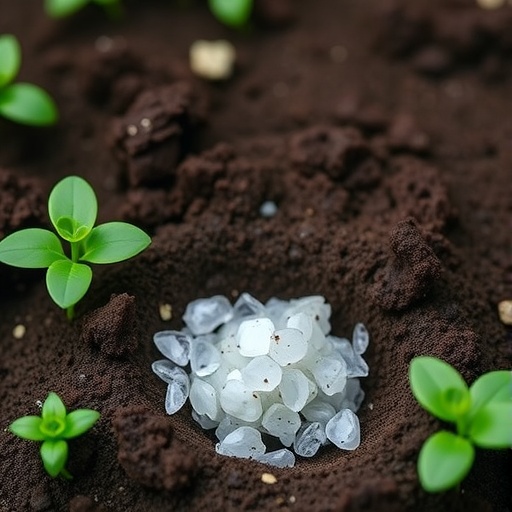In a rapidly changing world, the contributions of biotic and abiotic factors to soil carbon sequestration have become significant topics of research, highlighting Earth’s mechanisms for managing carbon storage. A groundbreaking study by He, Wang, Cao et al. investigates these contributions extensively, offering insights into the intricate dynamics that govern soil carbon levels, which are crucial for climate regulation and ecosystem health. Through their research, they unpack how both living organisms and non-living environmental elements interact within soil ecosystems to either promote or hinder the process of carbon sequestering, thereby influencing overall carbon storage in terrestrial systems.
Initially, the study addresses the vital role of soil in the global carbon cycle, noting that soils are not merely passive repositories but active participants in the dynamics of carbon exchange. Soil acts as a significant carbon sink, storing nearly three times more carbon than the atmosphere. This fact alone underscores the urgency for robust research to comprehend the underlying processes that dictate soil carbon dynamics. The authors argue that understanding these processes is not only key to predicting climate change impacts but also essential for developing effective strategies to enhance soil carbon sequestration.
The research categorizes various biotic influences, emphasizing the role of microbial communities in soil ecosystems. Microorganisms, including bacteria and fungi, play a fundamental role in the decomposition of organic matter, which enriches the soil with carbon compounds. These microbes utilize organic material for their growth and metabolic processes, thereby converting it into stable forms of soil organic carbon. The study delineates the types of microorganisms involved, their metabolic pathways, and how their diversity can significantly influence the rate of carbon sequestration in soils.
Moreover, the interplay between plant roots and soil microbiota is examined. Root exudates, which are organic compounds released by roots, serve as a primary food source for soil microorganisms. This interaction not only enhances microbial activity but also increases soil structure stability, creating a conducive environment for further carbon storage. The researchers highlight the importance of plant species diversity and the synergistic relationships between plants and soil microbes, suggesting that agricultural practices that enhance these relationships could optimize carbon sequestration.
On the abiotic side, the study emphasizes the role of soil properties, such as texture, mineral composition, and moisture retention. These factors influence the physical and chemical environment of the soil, affecting how organic matter is decomposed and carbon is retained. For example, clay-rich soils tend to stabilize organic carbon more effectively than sandy soils. The research explores how these properties can either promote or restrict microbial activity, thereby impacting the overall carbon storage capacity of different soil types.
In addition to discussing intrinsic soil properties, the authors examine external abiotic factors, such as temperature and precipitation dynamics. Climate change forecasts indicate shifts in these parameters, which could have profound effects on soil carbon dynamics. Warmer temperatures often accelerate microbial decomposition rates, potentially leading to increased carbon release from soils, thereby offsetting carbon sequestration efforts. The study stresses the need for adaptive management practices that account for these climatic changes, emphasizing a proactive approach to sustaining soil health and carbon storage.
Furthermore, the research investigates anthropogenic impacts on soil carbon sequestration. Agricultural practices, land-use changes, and urbanization can lead to soil degradation, significantly disrupting the delicate balance of soil ecosystems. The conversion of forested or grassland areas into agricultural land, for instance, often results in considerable carbon losses. The authors call for integrated land management strategies that promote sustainable practices, restoring degraded soils while also optimizing agricultural productivity. They argue that implementing agroecological practices could enhance soil carbon stocks while ensuring food security.
The research also delves into global initiatives aimed at increasing soil carbon sequestration as part of climate change mitigation strategies. Various countries and municipalities are implementing programs designed to protect and restore soil health, integrating carbon farming practices into existing agricultural systems. These initiatives reflect a growing recognition of soils as critical components in the fight against climate change, with policy measures that incentivize sustainable land use and carbon sequestration efforts.
In their conclusion, He and colleagues emphasize the importance of continued research into the biotic and abiotic factors influencing soil carbon sequestration. They call for an interdisciplinary approach, combining soil science, ecology, agriculture, and climate studies, to tackle the complexities of soil carbon dynamics effectively. The insights gained can inform policymakers, land managers, and farmers, creating a robust framework for enhancing soil health and maximizing carbon storage potential.
As we navigate the challenges posed by climate change, understanding the mechanisms of soil carbon sequestration and leveraging this knowledge for practical application will be paramount. This study serves as a stepping stone towards broader initiatives aimed at both conserving and revitalizing our planet’s soils, ultimately impacting global carbon cycles and climate stabilization efforts.
To sum up, the intricate web between soil dynamics and carbon sequestration highlights the essential role of both biotic and abiotic factors. As we delve deeper into these interactions, we uncover pathways to not only mitigate climate change but also promote healthier ecosystems. The impact of this research extends beyond academic spheres into practical applications, suggesting that the way forward lies in blending scientific knowledge with sustainable practices.
Subject of Research: Soil carbon sequestration and its influencing factors
Article Title: Biotic and abiotic influences on soil carbon sequestration: mechanisms and future perspectives
Article References: He, G., Wang, R., Cao, Z. et al. Biotic and abiotic influences on soil carbon sequestration: mechanisms and future perspectives. Environ Monit Assess 197, 1018 (2025). https://doi.org/10.1007/s10661-025-14471-y
Image Credits: AI Generated
DOI: 10.1007/s10661-025-14471-y
Keywords: Soil carbon sequestration, biotic factors, abiotic factors, microbial communities, root exudates, soil properties, climate change, anthropogenic impacts, sustainable agriculture, carbon farming.




